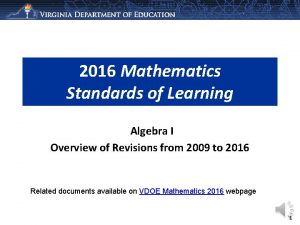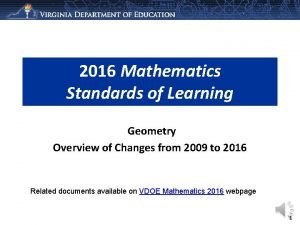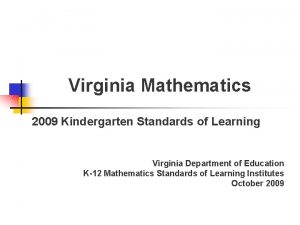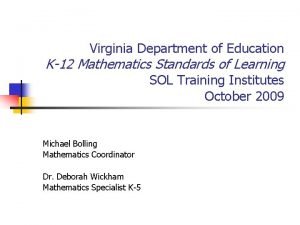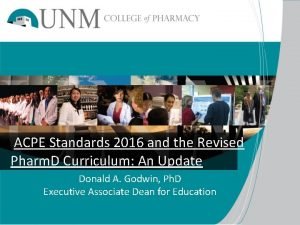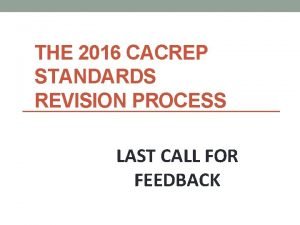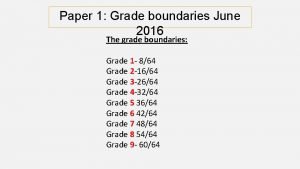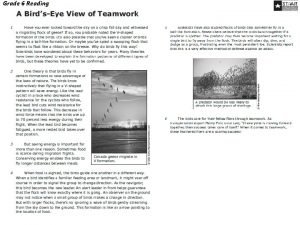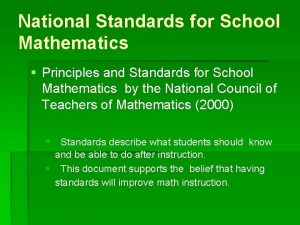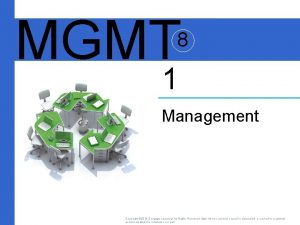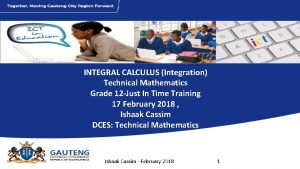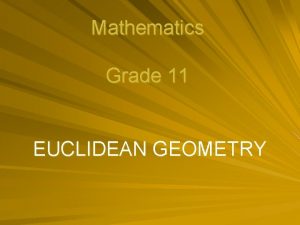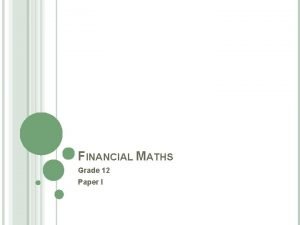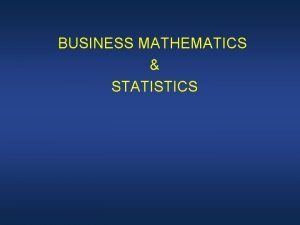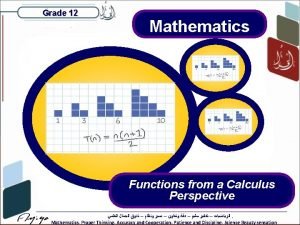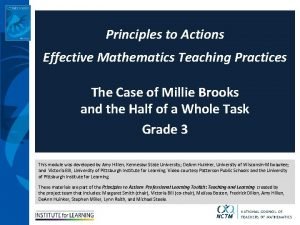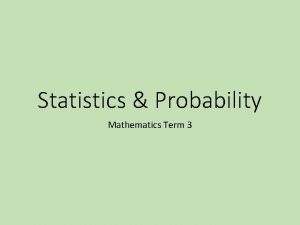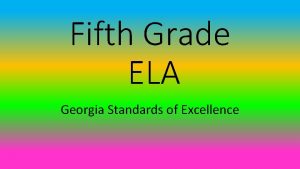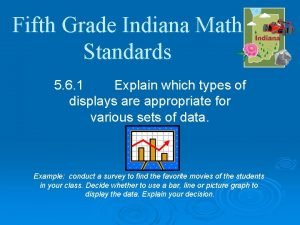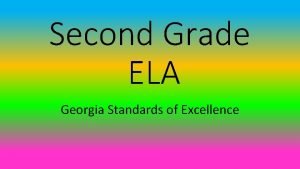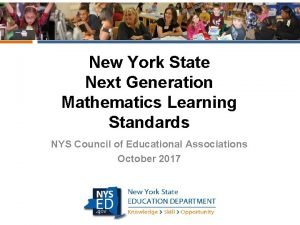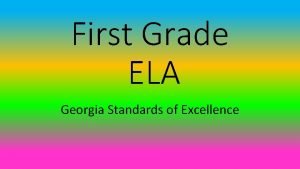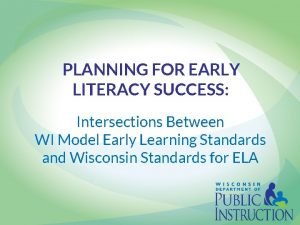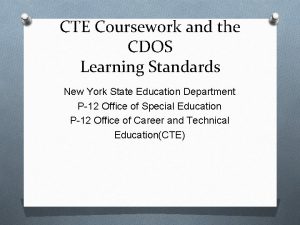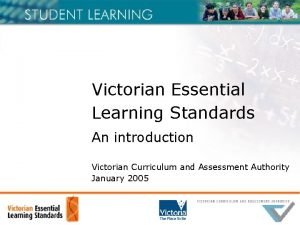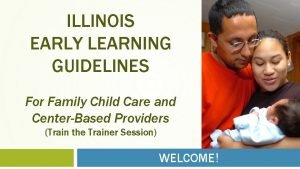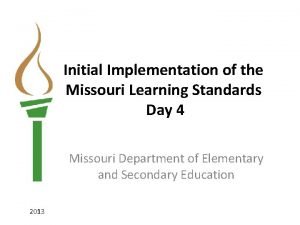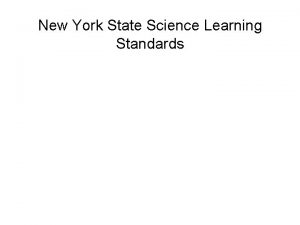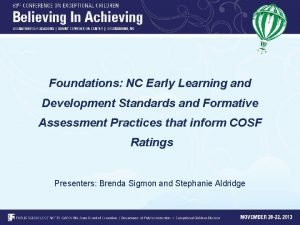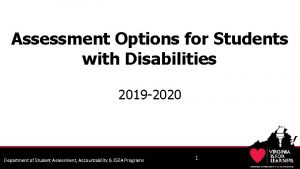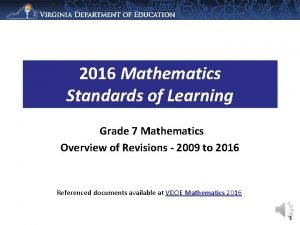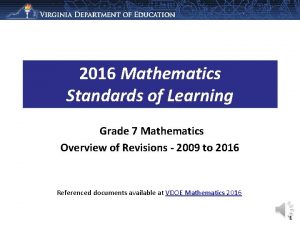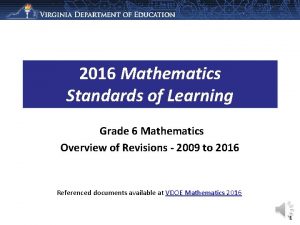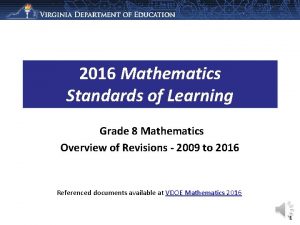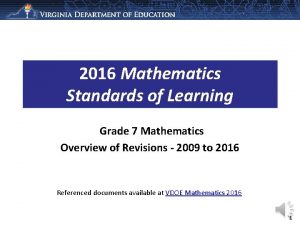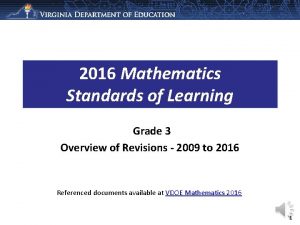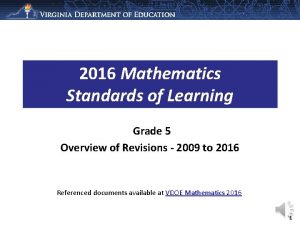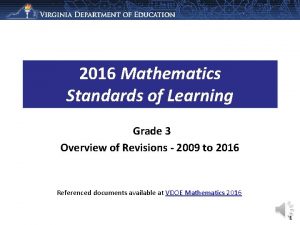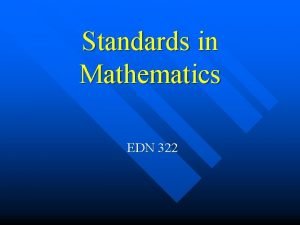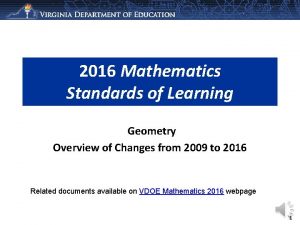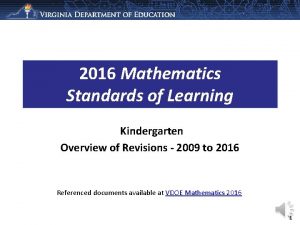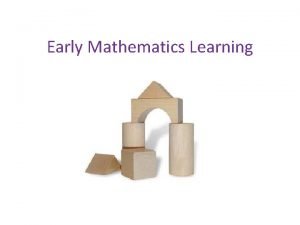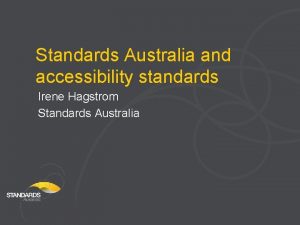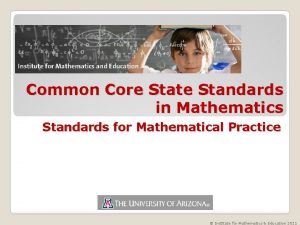2016 Mathematics Standards of Learning Grade 8 Mathematics










































- Slides: 42

2016 Mathematics Standards of Learning Grade 8 Mathematics Overview of Revisions - 2009 to 2016 Referenced documents available at VDOE Mathematics 2016 1

Purpose • Overview of the 2016 Mathematics Standards of Learning and the Curriculum Framework • Highlight information included in the Essential Knowledge and Skills and the Understanding the Standard sections of the Curriculum Framework 2

Agenda • Implementation Timeline • Resources Currently Available – Crosswalk (Summary of Revisions) – Standards and Curriculum Frameworks • Comparison of 2009 to 2016 Standards – – – Number and Number Sense Computation and Estimation Measurement and Geometry Probability and Statistics Patterns, Functions, and Algebra 3

Implementation Timeline 2016 -2017 School Year – Curriculum Development VDOE staff provides a summary of the revisions to assist school divisions in incorporating the new standards into local written curricula for inclusion in the taught curricula during the 2017 -2018 school year. 2017 -2018 School Year – Crossover Year 2009 Mathematics Standards of Learning and 2016 Mathematics Standards of Learning are included in the written and taught curricula. Spring 2018 Standards of Learning assessments measure the 2009 Mathematics Standards of Learning and include field test items measuring the 2016 Mathematics Standards of Learning. 2018 -2019 School Year – Full-Implementation Year Written and taught curricula reflect the 2016 Mathematics Standards of Learning assessments measure the 2016 Mathematics Standards of Learning. 4

2016 SOL Revisions – • Improve the vertical progression of mathematics content • Ensure developmental appropriateness of student expectations • Increase support for teachers in mathematics content (including definitions, explanations, examples, and instructional connections) • Clarify expectations for teaching and learning • Improve precision and consistency in mathematical language and format • Ensure proficiency of elementary students in computational skills 5

Changes to the Curriculum Framework • Reduction of columns from 3 to 2 – Understanding the Standard (US) – information that supports mathematical content knowledge – Essential Knowledge and Skills (EKS) – information that provides expectations for student learning • Indicators of SOL sub-bullet added to each bullet within the Essential Knowledge and Skills • Objectives measured without a calculator on state assessments are indicated with an asterisk * 6

7

Overview – Math 8 2009 Strand 2016 # of Standards Number and Number Sense 2 3 Number and Number Sense Computation and Estimation 3 1 Computation and Estimation Measurement 2 Geometry 4 6 Measurement and Geometry Probability and Statistics 2 3 Probability and Statistics Patterns, Functions, and Algebra 4 5 Patterns, Functions, and Algebra 17 18 Total Strand Total 8

Mathematics Process Goals for Students “The content of the mathematics standards is intended to support the five process goals for students” - 2009 and 2016 Mathematics Standards of Learning Communication Connections Problem Solving Representations Mathematical Understanding Reasoning 9

Standards of Learning Curriculum Frameworks Introduction includes: • Mathematical Process Goals for Students • Instructional Technology • Computational Fluency New • Algebra Readiness • Equity 10

2009 2016 11

12

NUMBER AND NUMBER SENSE 13

2009 SOL 8. 1 The student will a) simplify numerical expressions involving positive exponents, using rational numbers, order of operations, and properties of operations with real numbers; and [Combined with 8. 14 a] b) compare and order decimals, fractions, percents, and numbers written in scientific notation. [Moved to EKS] 2016 SOL 8. 1 The student will compare and order real numbers. Revisions: • Simplifying numerical expressions is combined with 8. 14 a evaluating an algebraic expression for given replacement values of the variables • Compare and order no more than 5 real numbers expressed as integers, fractions, mixed numbers, decimals, percents, numbers written in scientific notation, radicals (includes both positive and negative square roots) and π • Use rational approximations (to nearest hundredth) of irrational numbers to compare and order 14

2009 SOL 2016 SOL 8. 2 The student will describe orally and in writing 8. 2 The student will describe the relationships between the subsets of the real number system. Revisions: • No revisions 15

2009 SOL 2016 SOL 8. 3 The student will a) estimate and determine the two consecutive integers between which a square root lies; and [Moved from 8. 5 b] b) determine both the positive and negative square roots of a given perfect square. [Moved from 8. 5 EKS] Revisions: • 8. 3 a - Estimate and determine the two consecutive integers between which a positive or negative square root lies (expanded beyond whole numbers) 16

COMPUTATION AND ESTIMATION 17

2009 SOL 8. 3 The student will a) solve practical problems involving rational numbers, percents, ratios, and proportions; and b) determine the percent increase or decrease for a given situation. 2016 SOL 8. 4 The student will solve practical problems involving consumer applications. Revisions: • Solve practical problems involving consumer applications by using proportional reasoning • Reconcile an account balance given a statement with 5 or fewer transactions • Compute sales tax or tip and the total • Compute simple interest and new balance given the principal, interest rate, and time • Compute the percent of increase or decrease in a practical situation 18

2009 SOL 2016 SOL 8. 4 The student will apply the order of operations to evaluate algebraic expressions for given replacement values of the variables. [Moved to 8. 14 a] Revisions: • Moved to 8. 14 a in Patterns, Functions, and Algebra strand 19

2009 SOL 2016 SOL 8. 5 The student will a) determine whether a given number is a perfect square; and [Included in 7. 1] b) find the two consecutive whole numbers between which a square root lies. [Included in 8. 3 a] Revisions: • Removed from Grade 8 and included in 7. 1 d EKS - Determine whether a given number is a perfect square 20

MEASUREMENT AND GEOMETRY 21

2009 SOL 8. 6 The student will a) verify by measuring and describe the relationships among vertical angles, adjacent angles, supplementary angles, and complementary angles; and b) measure angles of less than 360°. 2016 SOL 8. 5 The student will use the relationships among pairs of angles that are vertical angles, adjacent angles, supplementary angles, and complementary angles to determine the measure of unknown angles. Revisions: • Use the relationship between pairs of angles that are vertical, adjacent, supplementary, and complementary to determine the measure of an unknown angle • Measure angles of less than 360° was removed 22

2009 SOL 8. 7 The student will 2016 SOL 8. 6 The student will a) investigate and solve practical problems involving volume and surface area of prisms, cylinders, cones, and pyramids; and a) solve problems, including practical problems, involving volume and surface area of cones and square-based pyramids; and b) describe how changing one measured attribute of a figure affects the volume and surface area. b) describe how changing one measured attribute of a rectangular prism affects the volume and surface area. Revisions: • Removed from Grade 8 and included in 7. 4 a – Volume and surface area of rectangular prisms and cylinders • Removed from Grade 8 and included in G. 13 – Volume and surface of triangular-based pyramids • Removed from Grade 8 – Describe the two dimensional figures that result from slicing a three-dimensional figure parallel to the base • 8. 6 b EKS – Describe volume of a rectangular prism when one attribute is multiplied by a factor of 1/4 , 1/3, 1/2, 2, 3, or 4 • 8. 6 b EKS – Describe surface area of a rectangular prism when one attribute is multiplied by factor of 1/2 or 2 23

2009 SOL 8. 8 The student will a) apply transformations to plane figures; and b) identify applications of transformations. 2016 SOL 8. 7 The student will a) given a polygon, apply transformations, to include translations, reflections, and dilations, in the coordinate plane; and b) identify practical applications of transformations. Revisions: • Removed from Grade 8 and included in Geometry – Rotate a figure 90°, 180°, 270°, and 360° [Included in G. 3] • Removed from Grade 8 and included in Geometry – Dilating a polygon from a fixed point not the origin [Included in G. 3] • 8. 7 a EKS – Translate a polygon both horizontally and vertically • 8. 7 a EKS – Restrict dilations to right triangles or rectangles to a scale factor of 1/4, 1/2, 2, 3, or 4 using the origin as center of dilation • 8. 7 a EKS – Both translate and then reflect a polygon over the x- or y-axis or reflect a polygon over the x- or y-axis and then translate 24

2009 SOL 8. 9 The student will construct a three-dimensional model, given the top or bottom, side, and front views. 2016 SOL 8. 8 The student will construct a three-dimensional model, given the top or bottom, side, and front views. Revisions: • No revisions 25

2009 SOL 8. 10 The student will a) verify the Pythagorean Theorem; and b) apply the Pythagorean Theorem. 2016 SOL 8. 9 The student will a) verify the Pythagorean Theorem; and b) apply the Pythagorean Theorem. Revisions: • No revisions 26

2009 SOL 8. 11 The student will solve practical area and perimeter problems involving composite plane figures. 2016 SOL 8. 10 The student will solve area and perimeter problems, including practical problems, involving composite plane figures. Revisions: • No revisions 27

PROBABILITY AND STATISTICS 28

2009 SOL 8. 12 The student will determine the probability of independent and dependent events with and without replacement. 2016 SOL 8. 11 The student will a) compare and contrast the probability of independent and dependent events; and [Moved from 6. 16] b) determine probabilities for independent and dependent events. Revisions: • 8. 11 a – Compare and contrast probability of two independent/dependent events • 8. 11 b EKS – Determine whether 2 events are independent or dependent 29

2009 SOL 2016 SOL 8. 12 The student will New a) represent numerical data in boxplots; b) make observations and inferences about data represented in boxplots; and c) compare and analyze two data sets using boxplots. [Moved from A. 10] Revisions: • New content for Grade 8 • Collect and display up to 20 data items in a boxplot • Use the five-number summary to describe the data • Compare and analyze two data sets using boxplots 30

2009 SOL 8. 13 The student will a) make comparisons, predictions, and inferences, using information displayed in graphs; and b) construct and analyze scatterplots. 2016 SOL 8. 13 The student will a) represent data in scatterplots; b) make observations about data represented in scatterplots; and c) use a drawing to estimate the line of best fit for data represented in a scatterplot. Revisions: • 8. 13 b - Make observations about data displayed limited to scatterplots only • 8. 13 c EKS – Estimate the line of best fit with a drawing 31

PATTERNS, FUNCTIONS, AND ALGEBRA 32

2009 SOL 2016 SOL 8. 14 The student will a) evaluate an algebraic expression for given replacement values of the variables; and [Moved from 8. 4 Computation and Estimation and 8. 1 a Number and Number Sense] b) simplify algebraic expressions in one variable. Revisions: • 8. 14 a - Use the order of operations and apply properties of real numbers to simplify and evaluate algebraic expressions • 8. 14 a - Evaluate algebraic expressions for given replacement values of the variables • • Limited to whole number exponents and integer bases • Limit number of replacements to three 8. 14 b - Simplify algebraic expressions in one variable • May require combining like terms • Expressions will include only linear and numeric terms • Coefficients and numeric terms may be rational 33

2009 SOL 2016 SOL 8. 15 The student will a) determine whether a given relation is a function; and b) determine the domain and range of a function. [Moved from 8. 17] Revisions: • 8. 15 a - Determine whether a given relation is a function using discrete points (ordered pairs, tables, and graphs) • • Sets of data are limited to no more than 10 ordered pairs 8. 15 b - Identify the domain and range moved from 8. 17 34

2009 SOL 2016 SOL 8. 14 The student will make connections between 8. 16 The student will any two representations (tables, graphs, words, a) recognize and describe the graph of a linear and rules) of a given relationship. [Included in function with a slope that is positive, 8. 15 a EKS and 8. 16 e] negative, or zero; b) identify the slope and y-intercept of a linear function given a table of values, a graph, or an equation in y = mx + b form; Revisions: • 8. 16 a - Recognize and describe a line with a slope that is positive/negative/zero • 8. 16 b - Identify slope and y-intercept of a linear function given a table, graph, or an equation in the form y = mx + b • y-intercept limited to integer values • Coordinates in the graph will be limited to integers 35

2009 SOL 2016 SOL 8. 14 The student will make connections between any 8. 16 The student will two representations (tables, graphs, words, and c) determine the independent and dependent rules) of a given relationship. [Included in 8. 15 a variable, given a practical situation modeled EKS and 8. 16 e] by a linear function; d) graph a linear function given the equation in y = mx + b form; and e) make connections between and among representations of a linear function using verbal descriptions, tables, equations, and graphs. Revisions: • 8. 16 c - Identify the dependent and independent variable in a practical situation • 8. 16 d - Graph a linear function • • y-intercept limited to integers 8. 16 e EKS - Write equation of a linear function in the form y = mx + b • Given the slope and y-intercept 36

2009 SOL 8. 15 The student will a) solve multistep linear equations in one variable with the variable on one and two sides of the equation; b) solve two-step linear inequalities and graph the results on a number line; and [Moved to 7. 13] c) identify properties of operations used to solve an equation. [Incorporated into EKS and US of 8. 14, 8. 17 and 8. 18] 2016 SOL 8. 17 The student will solve multistep linear equations in one variable on one or both sides of the equation, including practical problems that require the solution of a multistep linear equation in one variable. Revisions: • • Solve multistep equations with variable on one or both sides including practical problems • Up to 4 steps • Coefficients and numeric terms are rational • May require combining like terms • Apply properties of real numbers and properties of equality to solve Write verbal expressions and sentences as algebraic expressions and equations and vice versa 37

2009 SOL 2016 SOL New 8. 18 The student will solve multistep linear inequalities in one variable with the variable on one or both sides of the inequality symbol, including practical problems, and graph the solution on a number line. Revisions: • • Solve and graph multistep inequalities with variable on one or both sides of the inequality • Up to 4 steps • Includes practical problems • Coefficients and numeric terms are rational • Graph solutions on a number line • Apply properties of real numbers and properties of inequality to solve • May require combining like terms • Identify a value that is part of the solution set Write verbal expressions and sentences as algebraic expressions and inequalities and vice versa 38

2009 SOL 2016 SOL 8. 16 The student will graph a linear equation in two variables. [Incorporated into 8. 16 d] Revisions: • This SOL was incorporated into the 2016 SOL 8. 16 d 39

2009 SOL 2016 SOL 8. 17 The student will identify the domain, range, [Moved to 8. 15 b] independent variable, or dependent variable [Moved to 8. 16 c] in a given situation. Revisions: • Determine the domain and range moved to 8. 15 b • Determine the independent and dependent variable moved to 8. 16 c 40

Middle School Revisions Leading to Algebra I 41

Questions? Please contact us! Mathematics@doe. virginia. gov 42
 Algebra 1 sol 2016
Algebra 1 sol 2016 2016 mathematics standards of learning
2016 mathematics standards of learning Virginia kindergarten standards
Virginia kindergarten standards Vdoe vertical articulation
Vdoe vertical articulation Acpe standards 2016
Acpe standards 2016 Cacrep 2016 standards
Cacrep 2016 standards Cuadro comparativo e-learning y b-learning
Cuadro comparativo e-learning y b-learning June 2016 grade boundaries
June 2016 grade boundaries Staar released test
Staar released test Principles and standards for school mathematics
Principles and standards for school mathematics 2016 cengage learning
2016 cengage learning Factors necessary for service standards are
Factors necessary for service standards are Grade 12 integration
Grade 12 integration Curriculum management hod management plan template
Curriculum management hod management plan template Euclidean geometry grade 12 theorems
Euclidean geometry grade 12 theorems Grade 12 financial maths formulas
Grade 12 financial maths formulas Business math module 3 answer key
Business math module 3 answer key Mathematics functions grade 12
Mathematics functions grade 12 Establish mathematics goals to focus learning
Establish mathematics goals to focus learning Contextualized teaching and learning
Contextualized teaching and learning Learning intentions and success criteria for mathematics
Learning intentions and success criteria for mathematics Elagse
Elagse Indiana 3rd grade math standards
Indiana 3rd grade math standards Georgia reading standards 2nd grade
Georgia reading standards 2nd grade Next gen math standards
Next gen math standards Oklahoma 3rd grade math standards
Oklahoma 3rd grade math standards Ga ela standards
Ga ela standards Wmels performance standards
Wmels performance standards Cdos learning standards
Cdos learning standards Social emotional learning standards michigan
Social emotional learning standards michigan Victorian essential learning standards
Victorian essential learning standards Social emotional learning standards nj
Social emotional learning standards nj Indiana social emotional learning competencies
Indiana social emotional learning competencies Illinois early learning standards
Illinois early learning standards Washington state social emotional learning standards
Washington state social emotional learning standards 2017 english standards of learning curriculum framework
2017 english standards of learning curriculum framework How to write missouri learning standards
How to write missouri learning standards New york state learning standards science
New york state learning standards science Nc early learning standards
Nc early learning standards Vaap manual
Vaap manual Steps for computing grades
Steps for computing grades Cinderella dressed in yella jump rope song lyrics
Cinderella dressed in yella jump rope song lyrics Difference between grade a and grade aa eggs
Difference between grade a and grade aa eggs
